

7. Application to the synthesis of complex molecules |
273 |
|
|
hν |
|
AcO |
AcO |
|
H |
|
|
|
|
|
|
O |
O |
|
|
|
|
O |
O |
(42) |
OH − |
|
AcO |
|
|
O |
|
|
|
|
|
O |
|
O |
|
|
|
|
|
|
O |
O |
(44) |
|
(43) |
|
|
|
SCHEME 10
This was followed by immediate saponification of the enol ester to afford dieneone 43, which could be easily elaborated to 44.
The trans cis isomerization process observed in the eudesmane/germacrane ring system has been utilized for the synthesis of the cis-fused sesquiterpene occidentalol, 48a, and its 7-epi isomer, 48b (Scheme 11)22. Photolysis of the trans-fused diene 45 at 78 °C afforded triene 46, which upon warming underwent disrotatory electrocyclization to give 47a and 47b as a 1:2 mixture of diastereomers. Apparently, the carboalkoxy group imparts
hν |
|
|
CO2 Me |
CO2 Me |
|
H |
|
|
(45) |
(46) |
|
∆ |
|
|
MeLi |
|
|
CO2 Me |
|
|
H |
H |
OH |
|
||
(47a,b) |
(48a,b) |
|
SCHEME 11 |
|
|
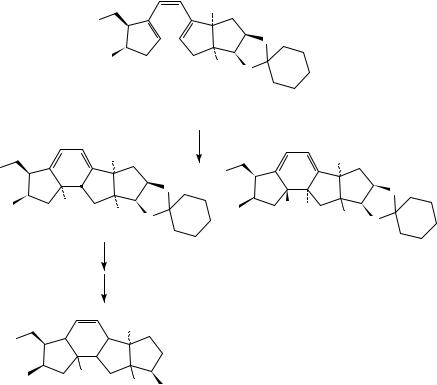
274 |
John M. Nuss and Frederick G. West |
little stereoinduction in the electrocyclization of triene 46. These diastereomers could be separated and they reacted with methyllithium to afford 48a and 48b in good yield.
Whitesell and Minton have reported an ingenous synthesis of the antimicrobial and amoebicidal agent ikarugamycin which utilizes a photochemically initiated conrotatory electrocyclization as its critical step (Scheme 12)23. These workers found that photolysis of a ca 2:1 mixture of the trienes 49a and 49b led to a 4:1 mixture of the two possible conrotatory closure products 50a and 50b in near-quantitative yield. This product ratio most likely reflects the conformational bias in the ground state of the (Z)-triene 49a, as it is likely that one conformer reacts to give 50a while the other conformer reacts to give 50b. Triene 49b is assumed to photochemically equilibrate with 49a, followed by conversion to 50a and 50b. Glycol 50a functioned as a key intermediate in the synthesis of the target compound.
|
7 |
8 |
|
|
|
|
|
H |
|
|
|
|
|
|
O |
|
|
|
|
H |
O |
|
|
|
|
|
|
|
|
|
|
(49a) (Z)-C7-C8 |
|
|
|
|
|
(49b) (E)-C7-C8 |
|
|
|
H |
|
hν |
|
H |
|
|
|
|
|
||
|
|
|
|
|
|
|
O |
+ |
|
|
O |
H |
|
|
H |
H |
|
H |
|
|
|
||
O |
|
|
H |
O |
|
|
|
|
|||
(50a) |
|
|
|
|
|
|
|
|
|
|
|
|
|
50a :50b |
|
|
(50b) |
|
|
4 : 1 |
|
|
|
H
• •
• OH
OH
H
H OH
SCHEME 12
Irradiation of conjugated trienes such as 51 can also lead to the formation of bicyclo[3.1.0]hexanes (52 or 53) via a process that can be considered as a formal [ 4s C2a] or [ 4a C 2s] cycloaddition (Scheme 13)17,24. Thus, triene 51 affords 52 and 53 via symmetry-allowed processes17. For example, allocimene 54 gave 55 (with other photoproducts)25, while ˛-phellandrene (56) gave 57, which upon further irradiation afforded 5826. These reactions would be of little interest were it not for the observation
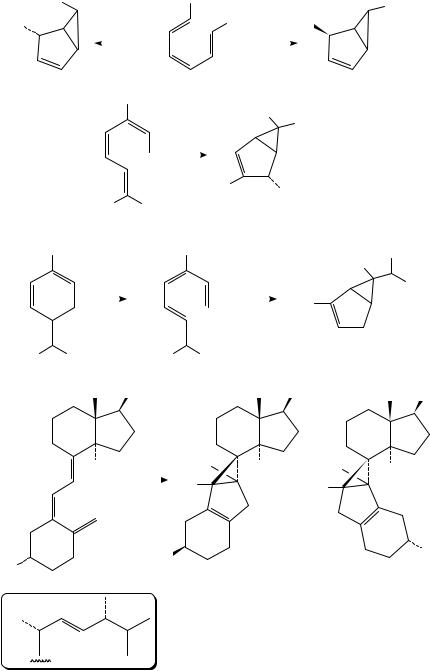
|
7. Application to the synthesis of complex molecules |
275 |
|||||||||||||
|
2 |
|
|
|
|
|
R1 |
|
|
|
|
R2 |
|||
|
R |
|
|
|
|
|
|
|
|
|
|
|
|
||
R1 |
|
|
|
|
|
|
|
|
|
R2 |
|
|
|
R1 |
|
|
|
|
hν |
|
|
|
|
|
|
hν |
|
|
|||
|
|
[π4s + π2a] |
|
|
|
|
|
[π4a + π2s] |
|
||||||
|
(52) |
|
|
|
|
|
(51) |
|
|
|
(53) |
|
|||
|
|
|
CH3 |
|
|
|
|
|
|
|
|
|
|||
|
|
|
|
|
|
|
|
|
|
|
|
H3 C |
|
||
|
|
|
|
|
|
|
|
|
|
|
|
|
CH3 |
|
|
|
|
|
|
CH3 |
hν |
|
|
|
|
|
|||||
|
|
|
|
|
H3 C |
|
|
CH3 |
|
||||||
|
|
|
|
|
|
|
|||||||||
|
|
|
|
|
|
|
|
|
|
|
|||||
|
H3 C |
|
CH3 |
|
|
|
|
|
|
|
|
|
|||
|
|
|
(54) |
|
|
|
|
|
|
(55) |
|
|
|
||
|
CH3 |
|
|
|
|
|
|
|
|
|
|
|
|
||
|
|
|
|
|
CH3 |
|
|
|
|
H |
CH3 |
||||
|
|
|
|
|
|
|
|
|
|
|
|
|
|
|
|
|
|
hν |
|
|
|
|
|
|
|
|
|
hν |
CH3 |
||
|
|
|
|
|
|
|
|
|
|
|
|
||||
|
|
|
|
|
|
|
|
|
|
|
|
|
H3 C |
|
|
H3 C |
CH3 |
|
|
|
H3 C |
CH3 |
|
|
|
||||||
|
|
|
|
|
|
|
|
|
|||||||
|
(56) |
|
|
|
|
|
(57) |
|
|
|
(58) |
|
|||
|
|
|
|
|
|
|
|
|
|
||||||
|
|
|
R |
|
|
|
|
|
|
R |
R |
||||
|
|
|
|
|
|
|
|
|
|
|
|
|
|
|
|
H |
H |
H |
H |
H |
|
|
hν |
H |
|
+ |
|
|
[π4s + π2a] |
|
H |
|
|
|
|
|
|
||
|
HO |
OH |
HO |
|
|
|
|
|
Vitamin D2 |
(59) |
(60) |
R =
SCHEME 13
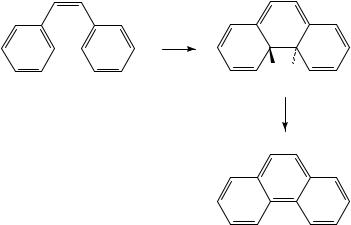
276 |
John M. Nuss and Frederick G. West |
that upon irradiation Vitamin D2 (calciferol) undergoes photocyclization to afford suprasterols 59 and 6027. The formation of these adducts, and their stereochemistry, can be nicely rationalized by a [ 4s C 2a] process.
The photocyclization of stilbenes to phenanthrene derivatives and related conjugated arylalkenes to polycyclic aromatic derivatives constitutes one of the most widely used applications of organic photochemistry to organic synthesis, owing primarily to the plethora of natural products containing a phenanthrene unit28. This reaction, in accordance with the accepted mechanism, starts from the excited state of the stilbene, which undergoes a six-electron, conrotatory electrocyclization to afford the dihydrophenanthrene (Scheme 14). In the majority of cases, however, this dihydrophenanthrene is unstable and undergoes either oxidation to the aromatic system (in the presence of oxygen or an oxidant such as iodine) or, less commonly, converts to the isomeric 9,10-dihydrophenanthrene by a hydrogen shift. Though somewhat outside the scope of the present discussion, this type of cyclization has been utilized effectively for the synthesis of a wide variety of complex systems; the reader is referred to numerous excellent review articles for further discussions of this subject28.
hν
H H
[O]
SCHEME 14
D. Sigmatropic Rearrangements
The Cope and Claisen rearrangements are the most widely utilized sigmatropic rearrangements from the standpoint of complex molecule synthesis. It has been found that the Cope rearrangement is frequently subject to great rate enhancements in the presence of catalysts; these most frequently have been either metal salts or acids29. However, there are several examples of the use of light to catalyze the [3,3] sigmatropic rearrangement of a 1,5-diene30. Some of these are shown in Scheme 15. The examples reported to date are a fairly random collection and it is not clear what factors facilitate the observed photochemical rearrangements, but it should be noted that in at least one case (61 to 62) photolysis reverses the normal equilibrium30d.
In what is one of the few examples of utilization of a higher order sigmatropic hydrogen shift in the synthesis of complex molecules, Eschenmoser, in studies directed toward the synthesis of Vitamin B12, found that an antarafacial [1,16] H-shift could be utilized to effect closure of secocorrin 63 to corrin 65 (Scheme 16)31. An intermediate biradical
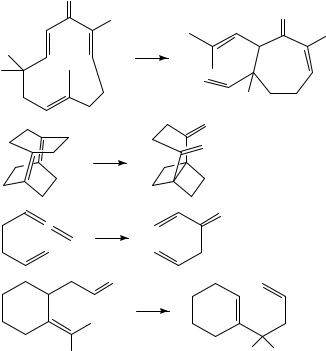
7. Application to the synthesis of complex molecules |
277 |
O
O
hν
hν
•hν
hν
CN |
|
|
CO2 Et |
NC |
CO2 Et |
(61) |
(62) |
|
SCHEME 15
64 is formed following the photochemically allowed H-shift. This then undergoes an antarafacial electrocyclic closure to form the desired product 65. The process has been found to be dependent upon the metal ion used, as reaction occurred with Li, Na, Mg, Ca, Zn, Cd, Pd or Pt ion present but failed to proceed with Co, Ni or Cu ion as the chelating agent.
E. Di-p-methane Rearrangements
While not formally conjugated, the electronic nature of 1,4-dienes is such that they participate in a wide variety of photochemical reactions and have a rich photochemical history. In particular, the photochemical rearrangement of a 1,4-diene to a vinylcyclopropane (66 to 67), the so-called di- -methane (DPM) rearrangement, is one of the most extensively studied photochemical rearrangements (Scheme 17)32. This process could be viewed as a formal 1,2-shift of a vinyl group with inversion of configuration of the migrating carbon atom32a. In reality, the mechanism is quite complex and has been investigated in exhaustive detail; the reader is referred to other articles for a detailed discussion of these aspects of this reaction. While this rearrangement has been utilized for the synthesis of a wide variety of unusual nonnaturally occurring ring systems, in particular the semibullvalenes and related compounds (e.g. 68 to 69)33, its use in the synthesis of natural products has been quite limited. In fact, it is quite surprising, given the level at which the di- -methane rearrangement has been studied and is understood, that this reaction has not
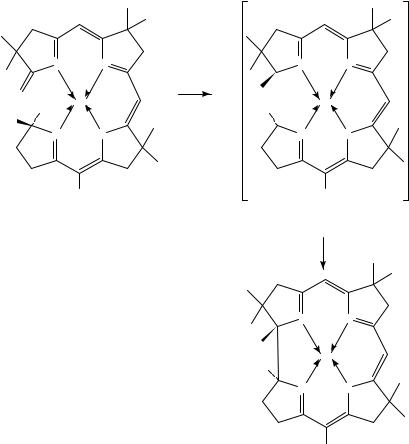
278 |
John M. Nuss and Frederick G. West |
N |
N |
• |
N |
N |
|
|
hν |
|
|
H |
M |
H |
|
M |
|
|
|
||
H |
|
• |
|
|
N |
N |
N |
N |
|
|
CN |
|
|
CN |
|
(63) |
|
|
(64) |
N N
M
H
N N
CN
(65)
SCHEME 16
been utilized more in complex molecule synthesis, especially given that the products of this rearrangement, namely vinylcyclopropanes, are quite valuable synthetic commodities34.
The first reported use of the DPM rearrangement in natural product synthesis can be found in the synthesis of methyl chrysanthemate, 71, reported by Pattenden and Whybrow (Scheme 18)35. This is produced directly by photolysis of 1,4-diene 70. While it should be noted that this reaction gave 71 in only 12% yield, it did furnish the desired product in a single step, with the correct relative stereochemistry. Bullivant and Pattenden also used a DPM rearrangement to form an advanced intermediate in the synthesis of the dideoxy derivative of the sesquiterpene taylorione, 7436. Irradiation of 72 afforded 73 in 45% isolated yield; this was then simply converted to 74 using standard transformations.
Armesto, Horspool and coworkers have extensively studied the related rearrangement of ˇ, -unsaturated imine derivatives, the so-called aza-di- -methane rearrangement37. A particularly interesting example is seen by the rearrangement of 75 to 76 (Scheme 19). Adduct 76 furnished chrysanthemic acid following a simple series of steps. It has been
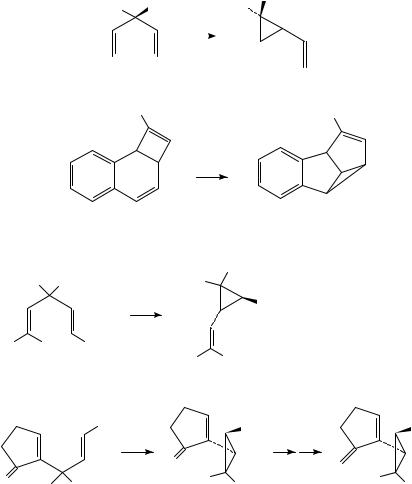
7. Application to the synthesis of complex molecules |
279 |
|||
|
|
|
R |
|
R |
R |
|
R |
|
|
|
hν |
|
|
|
(66) |
(67) |
|
|
|
NC |
|
NC |
|
|
|
|
|
|
hν
|
|
(68) |
|
|
|
(69) |
|
|
|
SCHEME 17 |
|
|
|
|
|
|
|
Me |
|
|
|
Me |
Me |
Me |
|
|
|
|
|
hν |
|
• |
CO2 Me |
|
|
|
|
|
|
||
Me |
Me |
CO2 Me |
|
|
|
|
|
|
|
Me |
Me |
|
|
|
(70) |
|
(71) |
|
|
|
|
|
C5H12 |
|
C5H12 |
C5H12 |
|
|
|
|
|
|||
|
|
hν |
|
|
|
|
|
|
|
O |
|
|
|
O |
Me |
Me |
|
Me |
|
Me |
|
Me |
|
Me |
|||
|
|
|
||||
|
(72) |
|
|
(73) |
|
(74) |
SCHEME 18
found that, in general, oxime derivatives undergo this rearrangement much more efficiently than do the corresponding imine or hydrazone derivatives.
Electrocyclization of 1,4-dienes is an efficient process when a heteroatom with a lone pair of electrons is placed in the 3-position, as in 77 (Scheme 20)38. Photoexcitation of these systems generally results in efficient formation of a C C bond via 6e conrotatory cyclization to afford the ylide 78. These reactive intermediates can undergo a variety of processes, including H-transfer (via a suprafacial 1,4-H transfer) to 79 or oxidation to 80. In a spectacular example of reaction, and the potential it holds for complex molecule synthesis, Dittami and coworkers found that the zwitterion formed by photolysis of divinyl ether 81 could be efficiently trapped in an intramolecular [3 C 2] cycloaddition by the

280 |
John M. Nuss and Frederick G. West |
Me Me
Me
hν
N
OAc
Me |
Me |
Me |
(75)
SCHEME 19
|
|
|
|
+ |
|
X |
|
|
X |
|
|
|
|
|
|
|
hν |
− |
|
|
|
|
|
|
|
|
|
|
|
R1 |
R2 |
X = O, NR, S |
|
|
|
R1 |
R2 |
||
|
(77) |
|
|
(78) |
CO2 Et
Me
71
N
OAc
Me
(76)
|
|
X |
Oxidation |
R1 |
R2 |
|
|
(80) |
H-shift |
H |
X |
|
R1 R2
(79)
CO2 Et
hν |
H |
O |
|
|
|
O |
|
|
O |
|
O |
(81) |
|
(82) |
SCHEME 20
pendant acrylate to afford 82 in 85% yield39. In general, these electrocyclizations are quite efficient and have been extensively utilized for the synthesis of a variety of complex molecules.
F. Rearrangements of Cross-conjugated Dienones
The mechanistic photochemistry of cross-conjugated 2,5-cyclohexadienones has been comprehensively examined (Scheme 21). The photochemical isomerization of the
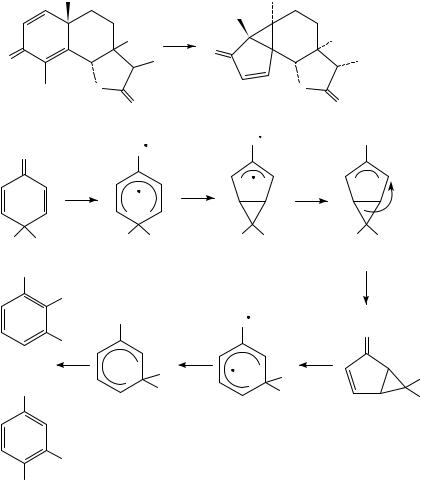
7. Application to the synthesis of complex molecules |
281 |
|
H |
hν |
|
H |
|
O |
|
O |
|
|
|
|
|
|
|
||
|
O |
|
|
O |
|
|
O |
|
|
O |
|
|
(83) |
|
|
|
|
|
O |
O |
|
O− |
|
O |
|
|
|
||
|
|
|
|
||
|
|
|
|
+ |
|
|
hν |
|
|
π*, n |
|
|
|
|
|
||
|
n,π* |
|
|
|
|
R R |
R R |
R R |
|
R R |
|
|
|
|
|
(84) |
|
OH |
|
|
|
|
|
|
R |
|
|
|
|
|
O− |
O |
|
|
|
|
|
|
O |
||
|
R |
|
|
||
|
|
|
|
||
+ |
+ |
π*,n |
|
hν |
|
R |
R |
n,π* |
|||
|
|
||||
OH |
|
R |
R |
|
|
|
|
|
|
||
|
(85) |
|
|
|
R
R
SCHEME 21
R
R
sesquiterpene santonin 83 was first noted more than a century ago. It was later found that these systems undergo photochemical rearrangement to ‘lumiketones’, with a net extrusion of C-4 and concomitant formation of a new cyclopropane ring40. The generally accepted mechanism for this rearrangement41,42 involves singlet n, Ł excitation, intersystem crossing to the longer-lived triplet state, bonding of the ˇ-carbons of the dienone system, electron demotion to a high-energy zwitterionic ground state and thermal [1,4]- rearrangement of the bicyclic zwitterion. Irradiation of the primary photoproduct gives phenolic secondary photoproducts. This appears to occur via fission of the ring-fusing cyclopropane bond to give a second, conjugated oxyallyl zwitterion 85, which then suffers [1,2]-migration of one of the substituents on the quaternary carbon. Evidence for 1,5-zwitterion 85 includes formation of the same products following its independent generation under non-photochemical conditions43.

282 |
John M. Nuss and Frederick G. West |
With the considerable degree of bond reorganization inherent in this rearrangement, it is not surprising that several laboratories have sought to exploit dienone photochemistry in synthesis. Simple, readily accessible quinone monoketals 86 and 87, which possess the cross-conjugated dienone chomophore, have been examined (Scheme 22)44. Upon irradiation, substrate 86 rearranged via the bicyclic oxyallyl intermediate to give the ethylene glycol monoester 88 of cyclopentenone-4-carboxylic acid44a. The presence of the electron-rich ketal unit allows for facile fragmentation of the cyclopropane ring of the intermediate. On the other hand, the corresponding dimethyl ketal 87 underwent photochemical conversion to 5-methoxycarbonylcyclopentenones 90, suggesting the intermediacy of dimethoxycyclopropane 8944b.
O
hν
A cOH
O O
O
(86)
O
hν
MeOH
MeO OMe
(87)
OH |
OH |
+
O
+
O
O
O
OCH2 CH2 OH
O
(88)
O O
CO2 Me
OMe
OMe
(89) |
(90) |
SCHEME 22
In the 1960s, Kropp showed that fused bicyclic dienones structurally related to santonin could potentially serve as synthetically useful precursors to either spirocyclic skeletons or hydroazulenones45. One of these cases, 91, was successfully used by Marshall and Johnson as the starting point in an elegant synthesis of the spirocyclic sesquiterpene ˇ-vetivone (Scheme 23)46. More recently, a variety of bicyclic cyclohexadienones have been studied by Caine and coworkers. For example, bicyclic dienone 92 could be photochemically rearranged to the oxygenated bicyclo[4.3.0]nonenone system 93, along with other rearrangement products, via acetic acid solvolysis of the cyclopropyl ketone intermediate47.
